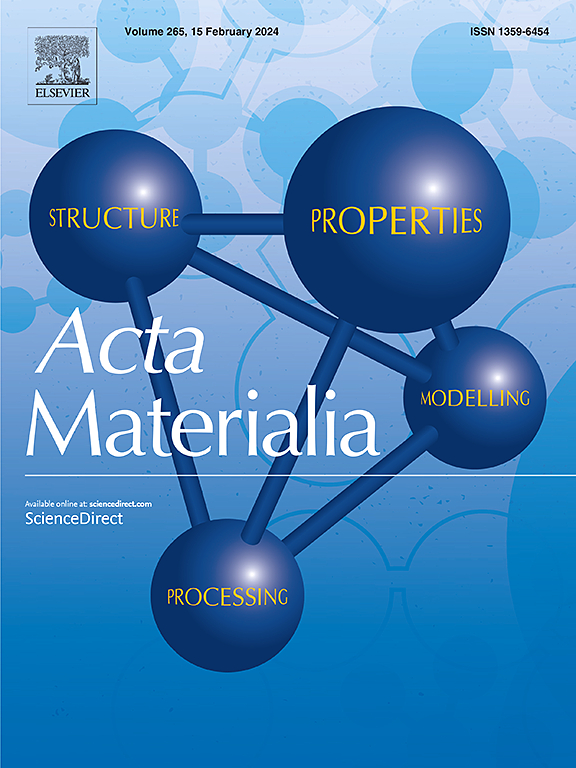Intermetallic dispersion-strengthened ferritic superalloys with exceptional resistance to radiation-induced hardening
IF 9.3
1区 材料科学
Q1 MATERIALS SCIENCE, MULTIDISCIPLINARY
引用次数: 0
Abstract
Intermetallic dispersion-strengthening (IDS) using nano-scale coherent intermetallic precipitates offers a potent strategy to produce high-strength and radiation-resistant steels, whilst addressing the manufacturability challenges of analogous oxide dispersion-strengthened (ODS) steels. However, their performance with intermetallic stability under irradiation damage, such as radiation-induced hardening (RIH), whilst hypothesised, is undemonstrated. Here, we report on a model IDS α(A2) + α’(L21) Fe-Ni-Al-Ti ferritic superalloy, which exhibits exceptional resistance to RIH with near-zero hardening after irradiation at 300 °C 1 dpa, in contrast to significant RIH in a counterpart coarse precipitate alloy (increase in nano-hardness of 1.0 GPa) and Eurofer97 (0.7 GPa). This irradiation resistance is attributed to the high density of semi-coherent precipitate-matrix interfaces, and partial-disordering L21->B2 which causes a decrease in anti-phase boundary energy. High interface density with localised interfacial strain offers effective sinks, suppressing defect populations compared to the counterpart with lower interface density. Meanwhile, atomic resolution spectroscopy and irradiation with in-situ transmission electron microscopy show that the disordering stems from Al-rich and Ti-rich sublattices mixing in the initial L21![]() Ni2AlTi structure below 500 °C, forming metastable B2-Ni(Al,Ti). Combined, the high interface density and radiation-induced intermetallic disordering underpin the remarkable radiation tolerance, demonstrating the IDS concept as a promising radiation-resistant materials design strategy.
Ni2AlTi structure below 500 °C, forming metastable B2-Ni(Al,Ti). Combined, the high interface density and radiation-induced intermetallic disordering underpin the remarkable radiation tolerance, demonstrating the IDS concept as a promising radiation-resistant materials design strategy.


金属间弥散强化铁素体高温合金,具有优异的抗辐射诱发硬化性能
利用纳米级相干金属间析出物进行金属间弥散强化(IDS)为生产高强度和抗辐射钢提供了一种有效的策略,同时解决了类似氧化物弥散强化(ODS)钢的可制造性挑战。然而,它们在辐照损伤下的金属间稳定性表现,如辐射诱发硬化(RIH),虽然是假设的,但尚未得到证实。在这里,我们报道了一种模型IDS α(A2) + α ' (L21) Fe-Ni-Al-Ti铁素体高温合金,该合金在300°C 1 dpa辐照后表现出优异的抗RIH性能,几乎为零硬化,而与之相对的粗相合金(纳米硬度增加1.0 GPa)和Eurofer97 (0.7 GPa)具有显著的RIH性能。这种抗辐照性能主要是由于半相干析出-基体界面的高密度和部分无序的L21->;B2导致了反相边界能的降低。与低界面密度相比,具有局部界面应变的高界面密度提供了有效的吸收,抑制了缺陷数量。同时,原子分辨光谱和原位透射电镜分析表明,在500℃以下,L21-Ni2AlTi初始结构中富Al亚晶格和富Ti亚晶格混合,形成亚稳态B2-Ni(Al,Ti)。高界面密度和辐射诱导的金属间无序结合在一起,支撑了卓越的辐射耐受性,证明了IDS概念是一种很有前途的抗辐射材料设计策略。
本文章由计算机程序翻译,如有差异,请以英文原文为准。
求助全文
约1分钟内获得全文
求助全文
来源期刊

Acta Materialia
工程技术-材料科学:综合
CiteScore
16.10
自引率
8.50%
发文量
801
审稿时长
53 days
期刊介绍:
Acta Materialia serves as a platform for publishing full-length, original papers and commissioned overviews that contribute to a profound understanding of the correlation between the processing, structure, and properties of inorganic materials. The journal seeks papers with high impact potential or those that significantly propel the field forward. The scope includes the atomic and molecular arrangements, chemical and electronic structures, and microstructure of materials, focusing on their mechanical or functional behavior across all length scales, including nanostructures.
 求助内容:
求助内容: 应助结果提醒方式:
应助结果提醒方式:


